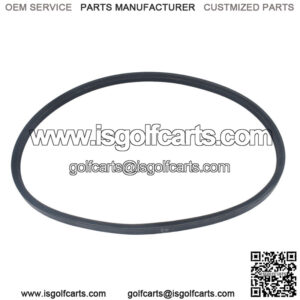Finding the Serpentine Belt
1
Pull the hood release inside the cabin of the vehicle. To access the serpentine belt, you will need to open the hood of the vehicle. The hood release can usually be found near the door on the driver’s side of the vehicle.
- With the hood released, you will also need to release the safety latch located at the front of the vehicle.
2
Disconnect the battery. You should always disconnect your battery before starting an automotive project. Use the appropriate sized wrench or socket to loosen the nut holding the black ground cable on the negative terminal of the battery.
- Slide the cable off of the terminal and tuck it to the side of the battery.
- You will not need to disconnect the positive terminal.
3
Locate the serpentine belt. Depending on the engine in your vehicle, the serpentine belt may be located at the front of the engine bay, or it may be along one side.There may be engine covers in the way, so be prepared to remove them if need be.
- Engine covers may be held in place by plastic clips, so take care not to break them as you remove the covers.
- If you cannot find your serpentine belt, refer to the service manual for your specific vehicle.
4
Look for signs of damage or wear on the belt. Once you have located the serpentine belt, inspect it visually for signs of damage. If the belt is frayed, coming apart, or has marks that indicate that it has been rubbing on something, it will need to be replaced.It is usually easy to determine if a belt needs to be replaced, as they tend to crack or lose chunks when they are overworn.
- Most serpentine belts need to be replaced every 40,000 to 70,000 miles.
- If there are signs of the belt rubbing on something, make sure to identify and repair whatever it was rubbing on to avoid damaging the new belt.
5
Find the serpentine belt routing diagram.
- Look in the owner’s or service manual for your specific year, make and model vehicle for a diagram.
- You can also take a picture of the existing belt with your cell phone to use as a guide when installing the new one.
Part2
Relieving the Tension on the Serpentine Belt
1
Determine if there is a belt tensioner pulley. Depending on the application, your serpentine belt will either have tension placed on it using a movable bracket or an auto tensioner pulley. This pulley uses an internal spring to apply consistent pressure to the belt at all times.
- Refer to your vehicle’s service manual to confirm what type of tensioner your vehicle uses if you aren’t sure.
2
Use a wrench to relieve the auto tensioner. Auto tensioners have either a hole that will fit a half inch drive ratchet, or a bolt you can use a socket to apply pressure to. Insert the wrench or place the socket over the bolt on the tensioner and twist it away from the belt to relieve the tension on it.
- Depending on the positioning of the tensioner pulley you may need to twist the tensioner clockwise or counterclockwise.
- Be sure to use the right size socket to avoid stripping the bolt head on the tensioner.
3
Loosen the bolts in the alternator bracket.
4
Pull the belt off of the pulleys. With the tension relieved from the belt, pull it off of the pulley that has been placing tension on it, then remove it from the around the rest of the pulleys on the engine.
Part3
Replacing the Serpentine Belt
1
Compare the new belt to the old one.
2
Route the belt through the pulleys.
3
Apply pressure on the auto tensioner and put the belt over it.
4
Increase the tension on the belt.“Keyword”
“how to install drive belt on ez go golf cart”
“how to measure a golf cart drive belt”
“golf cart drive belt not engaging”
“how to install drive belt on ez go golf cart”
“how to measure a golf cart drive belt”
“golf cart drive belt not engaging”

